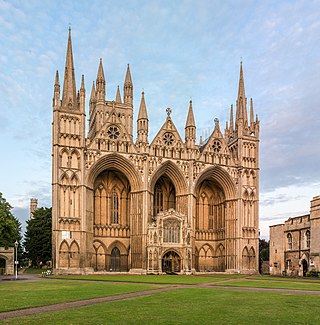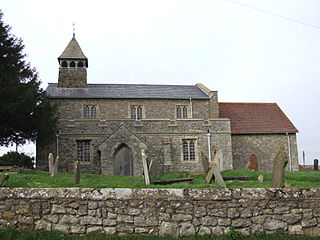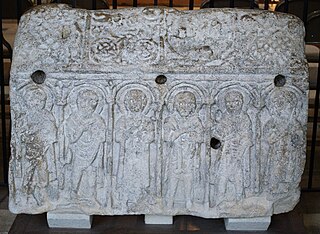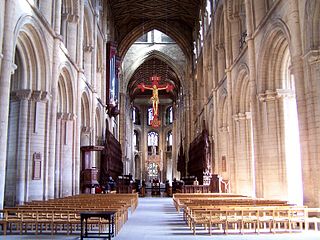
Peterborough is a cathedral city in the City of Peterborough district of Cambridgeshire, England. The city and its surroundings, the Soke of Peterborough, had an independent county council between 1889 and 1965. It formed part of the short-lived Huntingdon and Peterborough between 1965 and 1974. Before 1889, it was a liberty of Northamptonshire.

Bermondsey is a district in southeast London, part of the London Borough of Southwark, England, 2.5 miles (4.0 km) southeast of Charing Cross. To the west of Bermondsey lies Southwark, to the east Rotherhithe and Deptford, to the south Walworth and Peckham, and to the north is Wapping across the River Thames. It lies within the historic county boundaries of Surrey. During the Industrial Revolution Bermondsey became a centre for manufacturing, particularly in relation to tanning. More recently it has experienced regeneration including warehouse conversions to flats and the provision of new transport links.

Peterborough Cathedral, properly the Cathedral Church of St Peter, St Paul and St Andrew – also known as Saint Peter's Cathedral in the United Kingdom – is the seat of the Anglican Bishop of Peterborough, dedicated to Saint Peter, Saint Paul and Saint Andrew, whose statues look down from the three high gables of the famous West Front. Although it was founded in the Anglo-Saxon period, its architecture is mainly Norman, following a rebuilding in the 12th century. With Durham and Ely cathedrals, it is one of the most important 12th-century buildings in England to have remained largely intact, despite extensions and restoration.

Deusdedit was a medieval Archbishop of Canterbury, the first native-born holder of the see of Canterbury. By birth an Anglo-Saxon, he became archbishop in 655 and held the office for more than nine years until his death, probably from plague. Deusdedit's successor as archbishop was one of his priests at Canterbury. There is some controversy over the exact date of Deusdedit's death, owing to discrepancies in the medieval written work that records his life. Little is known about his episcopate, but he was considered to be a saint after his demise. A saint's life was written after his relics were moved from their original burial place in 1091.

Durobrivae was a Roman fortified garrison town located at Water Newton in the English county of Cambridgeshire, where Ermine Street crossed the River Nene. More generally, it was in the territory of the Corieltauvi in a region of villas and commercial potteries. The name is a Latinisation of Celtic *Durobrīwās, meaning essentially "fort bridges".

Bermondsey Abbey was an English Benedictine monastery. Most widely known as being founded in the 11th century, it had a precursor mentioned in the early eighth century, and was centred on what is now Bermondsey Square, the site of Bermondsey Market, Bermondsey, in the London Borough of Southwark, southeast London, England.

Allhallows is a village and civil parish on the Hoo Peninsula in Kent, England. Situated in the northernmost part of Kent, and covering an area of 23.99 km2, the parish is bounded on the north side by the River Thames, and in the east by the course of Yantlet creek, now silted up. At the 2011 census the parish had a population of 1,676.
Ealdwulf was a medieval Abbot of Peterborough, Bishop of Worcester, and Archbishop of York.

Cynesige was a medieval English Archbishop of York between 1051 and 1060. Prior to his appointment to York, he was a royal clerk and perhaps a monk at Peterborough. As archbishop, he built and adorned his cathedral as well as other churches, and was active in consecrating bishops. After his death in 1060, the bequests he had made to a monastery were confiscated by the queen.

Medeshamstede was the name of Peterborough in the Anglo-Saxon period. It was the site of a monastery founded around the middle of the 7th century, which was an important feature in the kingdom of Mercia from the outset. Little is known of its founder and first abbot, Sexwulf, though he was himself an important figure, and later became bishop of Mercia. Medeshamstede soon acquired a string of daughter churches, and was a centre for an Anglo-Saxon sculptural style.

Hugh Candidus was a monk of the Benedictine monastery at Peterborough, who wrote a Medieval Latin account of its history, from its foundation as Medeshamstede in the mid 7th century up to the mid 12th century.

The Dean of Peterborough is the head of the chapter at Peterborough Cathedral. On the Dissolution of Peterborough Abbey in 1539 and the abbey-church's refoundation as a cathedral for the new bishop and diocese of Peterborough, care for the abbey/cathedral church passed from an abbot to a dean. The current Dean of Peterborough is Chris Dalliston.
Seaxwulf was the founding abbot of the Mercian monastery of Medeshamstede, and an early medieval bishop of Mercia. Very little is known of him beyond these details, drawn from sources such as Bede's Ecclesiastical History. Some further information was written down in the 12th century at Peterborough Abbey, as Medeshamstede was known by that time. This suggests that he began his career as a nobleman, and that he may have had royal connections outside Mercia.
Headda was a medieval Bishop of Lichfield.
Gyrwas was the name of an Anglo-Saxon tribe of the Fens, divided into northern and southern groups and recorded in the Tribal Hidage; related to the name of Jarrow.
The Historia Ecclesie Abbendonensis or History of the Church of Abingdon was a medieval chronicle written at Abingdon Abbey in England in the 12th century. The Abbey was historically in the county of Berkshire, but since 1974 has been in the county of Oxfordshire.

Throughout its history the Kingdom of Mercia was a battleground between conflicting religious ideologies.
Nicholas Peter Brooks, FBA was an English medieval historian.

The Northamptonshire Record Society is a text publication society for the English county of Northamptonshire. It was established in 1920 by Joan Wake. The society is based at Wooton Hall Park in Northampton, with the Northamptonshire Record Office. It is a registered charity.













